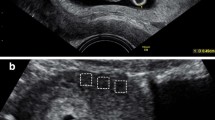Abstract
Purpose
To compare the placental pathologies and perinatal outcomes in fetal growth restriction (FGR) pregnancies with and without oligohydramnios.
Methods
A retrospective cohort study, comparing placental findings in all singleton deliveries with FGR.
Results
Macroscopic placental findings were available for 1,104 singleton FGR pregnancies. A total of 397 placentas were microscopically examined; of which 89 placentas were of FGR neonates who had oligohydramnios. No significant differences in placental vascular mal-perfusion were found between pregnancies with and without oligohydramnios (69.3 vs. 74.3%; P = 0.357). Likewise, no significant differences were noted between the groups regarding diffuse villous fibrosis (10.1 vs. 4.9%; P = 0.573), and amnion cell metaplasia (65.9 vs. 64.3%; P = 0.779). Cases of FGR complicated with oligohydramnios had significantly higher rates of perinatal mortality (9.9 vs. 5.9%; P = 0.028), preterm deliveries (34.9 ± 3.4 vs. 35.4 ± 3.1 weeks of pregnancy; P = 0.041), and lower birth weight (1,737 ± 542 vs. 1,845 ± 467 g; P = 0.002) compared to FGR without oligohydramnios.
Conclusions
Oligohydramnios is a significant risk factor for adverse perinatal outcome in FGR pregnancies; nevertheless, no significant differences in placental pathologies were noted.


Similar content being viewed by others
References
Klaitman V, Hershkovitz R, Sheiner E (2009) The epidemiology of intrauterine growth restriction. In: Sheiner E (ed) Textbook of perinatal epidemiology. Nova Science Publishers, Inc, Hauppauge
Harman CR (2008) Amniotic fluid abnormalities. Semin Perinatol 32:288–294
Chhabra S, Dargan R, Bawaskar R (2007) Oligohydramnios: a potential marker for serious obstetric complications. J Obstet Gynecol 27:680–683
Ott WJ (2005) Reevaluation of the relationship between amniotic fluid volume and perinatal outcome. Am J Obstet Gynecol 195:1803–1809
Rutherford SE, Smith CV, Phalen JP et al (1987) The four quadrant assessment of amniotic fluid volume: an adjacent to antepartum fetal heart rate testing. Obstet Gynecol 87:353–356
Moore TR, Cayle JE (1990) The amniotic fluid index in normal pregnancy. Am J Obstet Gynecol 162:1168–1173
Villar J, Carroli G, Wojdyla D, World Health Organization Antenatal Care Trial Research Group et al (2006) Preeclampsia, gestational hypertension and intrauterine growth restriction, related or independent condition? Am J Obstet Gynecol 194(4):921–931
Salafia CM, Minior VK, Pezzullo JC et al (1995) Intrauterine growth restriction in infants of less than thirty-two weeks’ gestation: associated placental pathologic features. Am J Obstet Gynecol 173:1049–1057
Salafia CM, Vintzileos AM, Silberman L et al (1992) Placental pathology of idiopathic intrauterine growth retardation at term. Am J Perinatol 9(3):179–184
Salafia CM, Charles AK, Mass EM Placenta and Fetal Growth Restriction. Clin Obs and Gyn 49:236–256
Kreiser D, el-Sayed YY, Sorem KA et al (2001) Decreased amniotic fluid index in low risk pregnancy. J Reprod Med 46:743–746
Pelpert JF, Donnenfeld AE (1991) Oligohydramnios: a review. J Obstet Gynecol Surv 46(6):325–339
Conflict of interest statement
None.
Author information
Authors and Affiliations
Corresponding author
Rights and permissions
About this article
Cite this article
Apel-Sarid, L., Levy, A., Holcberg, G. et al. Placental pathologies associated with intra-uterine fetal growth restriction complicated with and without oligohydramnios. Arch Gynecol Obstet 280, 549–552 (2009). https://doi.org/10.1007/s00404-009-0937-z
Received:
Accepted:
Published:
Issue Date:
DOI: https://doi.org/10.1007/s00404-009-0937-z




